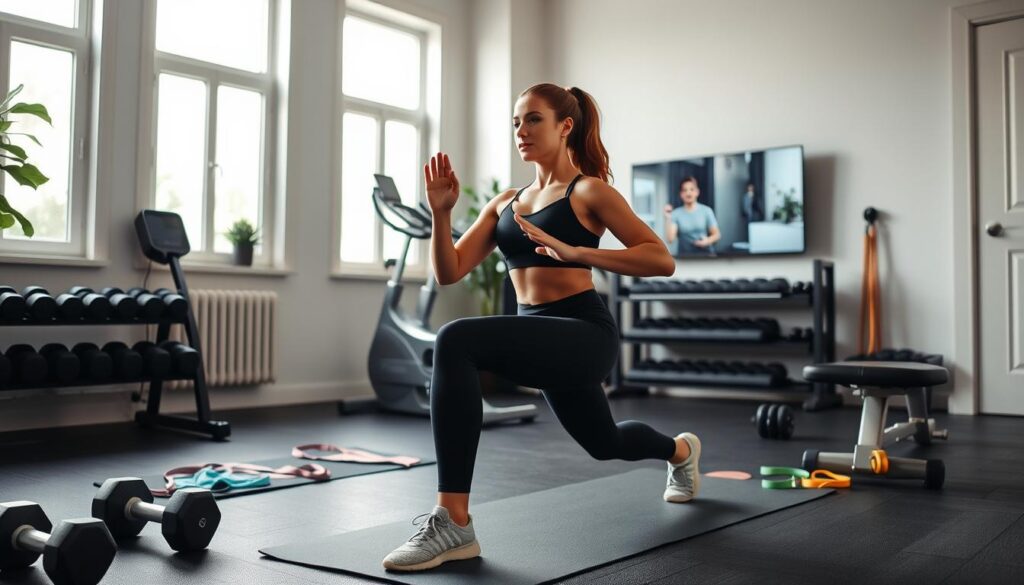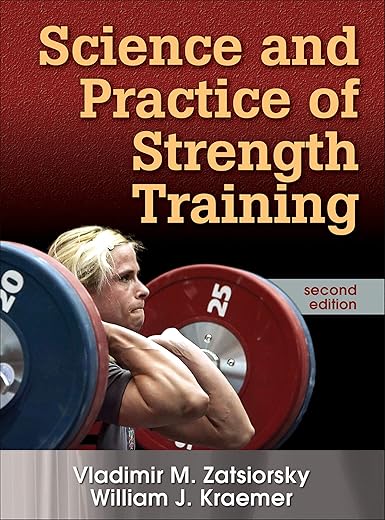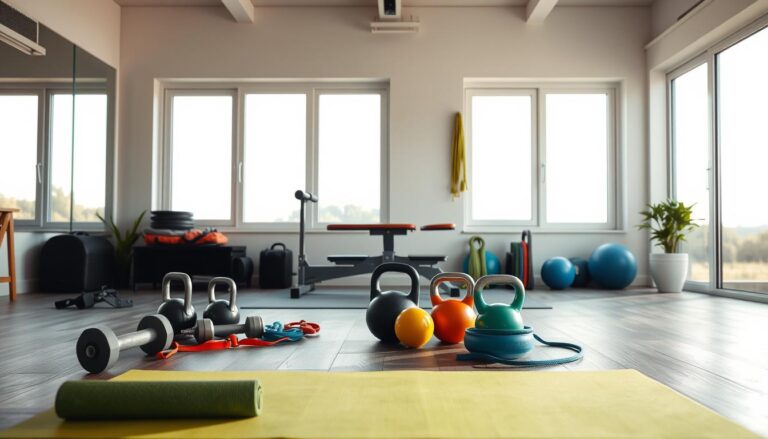Creating a Balanced exercise workout routine at Home
If you work from home, it’s key to have a good effective home exercise routine. Starting a fitness program is a great health choice. It can reduce the risk of chronic diseases and boost balance and coordination.
A home workout routine can be made just for you. It’s perfect for those who work from home. By mixing different exercises, you can get a balanced exercise workout routine at home that fits your goals.
Key Takeaways
- Regular exercise can lower the risk of chronic diseases.
- A home workout routine can be tailored to individual needs.
- Incorporating a variety of exercises can help achieve fitness goals.
- A balanced exercise routine can improve overall health and well-being.
- Exercise can improve balance and coordination.
The Importance of Exercise for Remote Workers
Remote workers face a big challenge in balancing work and personal life. Exercise is key to keeping this balance. It helps them stay healthy and focused.
Exercise fights the dangers of sitting too much. It prevents weight gain, keeps the heart healthy, and boosts mobility. A balanced workout schedule is essential for remote workers’ health.
Physical Health Benefits
Exercise brings many physical benefits. It helps with weight loss and improved sleep quality. It also lowers the risk of diseases like diabetes and heart disease.
A good at home exercise plan keeps the body fit and safe from injuries. It’s a must for remote workers.

Mental Health Benefits
Exercise is great for the mind too. It reduces stress and anxiety, lifts mood, and boosts well-being. For remote workers, it’s a break from isolation.
It also improves self-esteem and productivity. A home workout routine is a valuable tool for a better life.
Assessing Your Fitness Level and Goals
Before starting a home fitness regimen, it’s key to know your fitness level and goals. This helps create a personalized home fitness plan. You’ll understand your strengths and weaknesses, making your indoor workout routine fit your needs.
To do this, you must look at several important fitness aspects.
Determining Your Current Fitness Status
First, measure your aerobic and muscular fitness, flexibility, and body composition. Check how long you can walk or run a distance to see your aerobic fitness. See how long you can do aerobic exercises before getting tired.
For muscular fitness, try doing push-ups or squats. Flexibility is about your range of motion. Body composition is about your body fat percentage.

Setting Realistic and Measurable Goals
After knowing your fitness status, set realistic and measurable goals. Decide what you want to achieve with your home fitness regimen. Maybe you want to lose body fat, boost endurance, or improve health.
Your goals should be reachable in a certain time frame. You should also be able to track your progress. Clear goals help keep you motivated and focused on your fitness goals.
Creating a Balanced Exercise Workout Routine at Home
Working from home can be tough on your health. But, a good home workout routine can change that. It helps you stay fit, feel better physically, and boosts your mood.
A balanced exercise workout routine at home mixes aerobic, strength, and flexibility exercises. This mix keeps your heart healthy, builds muscle, and improves flexibility.
Components of a Well-Rounded Routine
A great effective home exercise routine has a few key parts:
- Aerobic Exercise: Activities like brisk walking, jogging, cycling, or swimming that raise your heart rate and improve cardiovascular health.
- Strength Training: Exercises that help build muscle, such as bodyweight exercises, resistance band exercises, or weightlifting.
- Flexibility Exercises: Stretching exercises that help improve flexibility and reduce the risk of injury.
Scheduling Your Workouts Around Work Hours
It’s important to plan your workouts around your work schedule. Here are some tips:
- Morning Workouts: Starting your day with a workout can help boost energy and set a positive tone for the day.
- Lunch Break Workouts: Taking a break during your lunch hour to exercise can help reduce stress and improve productivity.
- Evening Workouts: Exercising in the evening can help relieve tension and prepare your body for rest.
By adding these elements to your effective home exercise routine and fitting them into your schedule, you can create a balanced exercise workout routine at home. This will help you reach your fitness goals.
Essential Equipment for Home Workouts
Starting a home workout routine doesn’t need a lot of equipment. Many exercises use your body weight as resistance. This makes it easy for anyone to start an at home exercise plan without spending much.
No-Equipment Options
For those who don’t want to buy equipment or have little space, there are many indoor workout routine options. Yoga and strength training exercises that use your body weight are great. You can do push-ups, squats, lunges, and planks at home. These exercises help keep you strong and fit.
Budget-Friendly Equipment Recommendations
If you want to add equipment to your home workout routine, there are affordable options. Resistance bands and dumbbells are good choices because they’re versatile and cheap. Here’s a look at some budget-friendly equipment:
| Equipment | Cost | Versatility |
|---|---|---|
| Resistance Bands | $5-$15 | High |
| Dumbbells | $10-$30 | Moderate |
| Yoga Mat | $10-$20 | Low |
Cardiovascular Exercises for Home Workers
Home workers can greatly benefit from cardiovascular exercises. They help improve physical health and reduce the risks of a sedentary lifestyle.
These exercises are key for a healthy heart and better physical fitness. They burn calories, boost endurance, and enhance mental well-being.
Low-Impact Cardio Options
Low-impact cardio is perfect for beginners or those with health concerns. Examples include brisk walking, jogging in place, and cycling.
These exercises require no special equipment. They’re easy to do at home, making them great for home workers.
High-Intensity Interval Training (HIIT)
HIIT involves short, intense exercise followed by rest. It’s great for boosting fitness and burning calories.
Try sprinting in place, burpees, or jump squats for HIIT exercises.
Incorporating Cardio Into Your Work Day
Home workers can add cardio to their day with short breaks. This reduces sitting time and boosts health.
| Exercise | Duration | Intensity |
|---|---|---|
| Brisk Walking | 10 minutes | Moderate |
| Jogging in Place | 5 minutes | High |
| Cycling | 10 minutes | Moderate |
Adding these exercises to your daily routine can greatly enhance physical and mental health for home workers.
Strength Training Exercises Without a Gym
Working from home? Adding strength training exercises to your day can boost health and work performance. It’s key for keeping muscles strong and preventing weakness from too much sitting.
Starting a home workout routine with strength training can make you healthier and lower injury risks. You can do many exercises without needing gym equipment.
Upper Body Strengthening for Desk Workers
Desk workers can do upper body strengthening exercises at home. Try push-offs, wall push-ups, and arm circles. These exercises boost upper body strength and cut down on computer strain.
- Push-offs: Use a wall or desk to support your arms and shoulders.
- Wall Push-Ups: Easier on your joints than regular push-ups, perfect for home.
- Arm Circles: Hold arms straight, make small circles with your hands to loosen and strengthen shoulders.
Lower Body and Core Exercises
Lower body and core exercises are vital for staying fit and can be done without equipment. Squats, lunges, and calf raises work the legs. Planks and leg raises target the core.
- Squats: Stand with feet apart, lower down, then stand up.
- Lunges: Start with feet together, step forward with one foot, lower down, then return.
- Calf Raises: Stand on a step, raise heels, then lower them back down.
Full-Body Bodyweight Routines
Full-body bodyweight routines are great for strengthening many muscle groups at once. Burpees, mountain climbers, and squat jumps are effective at home. They boost both strength and heart health.
- Burpees: A full-body exercise that includes a squat, push-up, and jump.
- Mountain Climbers: Start in a plank, bring one knee up, then quickly switch to the other.
- Squat Jumps: Squat, then jump up to improve power and heart health.
Adding these strength training exercises to your home workout routine can improve health, productivity, and reduce sitting risks.
Flexibility and Mobility Workouts
Adding flexibility and mobility workouts to your day can boost your health, especially for those working from home. Home workers often sit for long hours. It’s key to do exercises that boost flexibility and mobility.
Stretching Routines to Counter Prolonged Sitting
Sitting for too long can make you less flexible and tense your muscles. A stretching routine can fight these issues. Try simple stretches like neck tilts, shoulder rolls, and hip flexor stretches at your desk or during breaks. These can enhance flexibility and lower injury risks.
Here are some stretching routines to try:
- Neck stretches: Slowly tilt your head to the side, bringing your ear towards your shoulder.
- Shoulder rolls: Roll your shoulders forward and backward in a circular motion.
- Hamstring stretches: Stand with your feet shoulder-width apart and lean forward, stretching the back of your legs.
Yoga Sequences for Home Practice
Yoga is great for boosting flexibility, mobility, and well-being. Even with little space, simple yoga sequences can be done at home. Here are some good yoga sequences for home workers:
- Sun salutations: A flowing sequence that stretches and strengthens the entire body.
- Downward-facing dog: Stretches the hamstrings, calves, and spine.
- Seated forward bend: Stretches the hamstrings, calves, and back.
By adding these workouts to your daily routine, you can better your health and fight the bad effects of sitting too long.
| Exercise | Benefits | Frequency |
|---|---|---|
| Neck Stretches | Improves flexibility, reduces muscle tension | Daily |
| Yoga Sequences | Improves flexibility, mobility, and overall well-being | 3-4 times a week |
| Hamstring Stretches | Stretches hamstrings, calves, and back | Daily |
Counteracting the Effects of Sitting All Day
Sitting for long periods can cause back pain and lower mobility. It’s important to add posture-improving exercises and movement breaks to your day. Remote workers often sit for hours, so it’s key to include home workout routines to fight these issues.
Posture-Improving Exercises
Good posture helps avoid back pain and other problems from sitting too much. Exercises can strengthen the spine and improve flexibility. Here are some posture-improving exercises:
- Chest stretches: Stand in a doorway with your hands on the doorframe at shoulder height, lean forward until you feel a stretch in your chest and shoulders.
- Shoulder blade squeezes: Sit or stand with your arms at your sides, squeeze your shoulder blades together, and hold for a few seconds before releasing.
- Upper back stretches: Place your hands on a wall or door at shoulder height, and lean forward, stretching your upper back and shoulders.
Movement Breaks to Reduce Sedentary Time
Adding movement breaks to your day can cut down on sitting time. This helps avoid the bad effects of sitting for too long. Here are some tips:
| Activity | Duration | Frequency |
|---|---|---|
| Standing and stretching | 2-3 minutes | Every 30 minutes |
| Short walk or jog | 5-10 minutes | Every 2 hours |
| Desk-based exercises | 2-5 minutes | Every hour |
By taking these movement breaks and doing posture-improving exercises daily, you can lessen the risks of sitting too much. This helps keep you healthy as a remote worker.
Quick Workout Breaks During the Workday
Remote workers can stay fit and focused with quick exercise breaks. Simple activities like stretching, jumping jacks, or a short walk can boost energy and productivity. These short sessions make it easier to handle work tasks.
For more tips on home workouts, check out Fitness Gear Authority. They have lots of info on exercises and gear.
5-Minute Energy-Boosting Exercises
Here are some quick exercises to boost your energy:
- Jumping jacks: 30 seconds
- Arm circles: 30 seconds
- Leg swings: 30 seconds
- Bodyweight squats: 10-15 reps
- Push-ups: 5-10 reps
Do these exercises in a row, resting for 1 minute between each.
Desk-Based Movement Routines
Exercises you can do at your desk are great for staying active. Here are some examples:
| Exercise | Duration | Reps |
|---|---|---|
| Chair squats | 30 seconds | 10-15 |
| Desk push-ups | 30 seconds | 5-10 |
| Leg raises | 30 seconds | 10-15 |
These exercises can improve blood flow, reduce muscle tension, and increase energy.
Creating a Dedicated Workout Space at Home
Having a dedicated workout area at home can keep remote workers motivated and on track with their fitness goals. A dedicated space is key to sticking to a home workout routine. It’s especially helpful for those working from home, as it separates work from exercise.
A dedicated space boosts motivation to exercise. A well-organized area also makes workouts more effective and enjoyable.
Space-Saving Solutions
Many homes have limited space for workouts. Space-saving solutions include using corners or walls for exercise areas. Foldable or multi-functional equipment and a tidy space are also helpful. These tips can turn even small homes into great workout spots.
Setting Up an Ergonomic Exercise Area
An ergonomic exercise area is vital for safety and comfort. It means choosing the right flooring, ensuring good lighting, and using ergonomic equipment. An ergonomic setup improves workout safety and effectiveness.
Preventing Injuries and Maintaining Proper Form
Keeping safe and effective in your home workout is crucial. Without a trainer, it’s easy to forget about proper form. This can lead to injuries that might stop you from reaching your fitness goals.
Common Home Workout Mistakes
Many mistakes can cause injuries during home workouts. These include poor warm-up or cool-down routines, ignoring proper form, and overloading weights or resistance. It’s key to know the right techniques for each exercise. For example, when doing squats or lunges, make sure your knees are in line with your toes to protect your joints.
Not listening to your body can also cause injuries. It’s important to know the difference between muscle fatigue and pain, which might mean you’re injured. By avoiding these common mistakes, you can lower your injury risk a lot.
Self-Assessment Techniques for Form
To keep proper form, using self-assessment techniques is helpful. One good way is to record yourself doing exercises and then watch the video to see if you’re doing it right. You can also use mirrors or reflective surfaces to check your form as you do it.
Another great technique is to focus on one part of form at a time. For instance, when doing dumbbell curls, pay attention to keeping your elbows close to your body and not swinging. By focusing on proper form, you can get better at your exercises and stay safe.
Conclusion
Having a home workout routine is key for those working from home. It helps fight the bad effects of sitting too much. A good routine should mix cardio, strength training, and flexibility exercises for full fitness.
Designing a home workout that fits your goals and schedule is easy. You can do exercises that boost heart health, build strength, and improve flexibility. This way, you stay fit without needing a gym.
Starting a home exercise plan can greatly improve your health and mind. It’s a smart way to care for yourself, even when you’re at home. So, get moving and enjoy the benefits!






